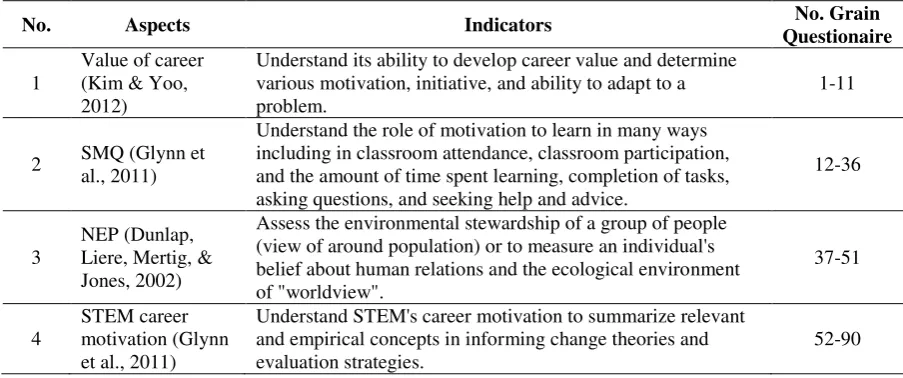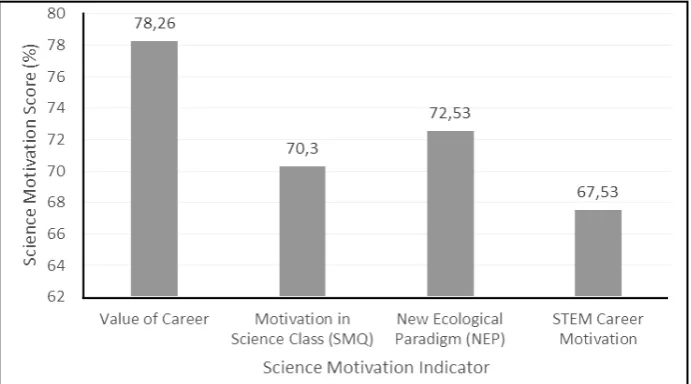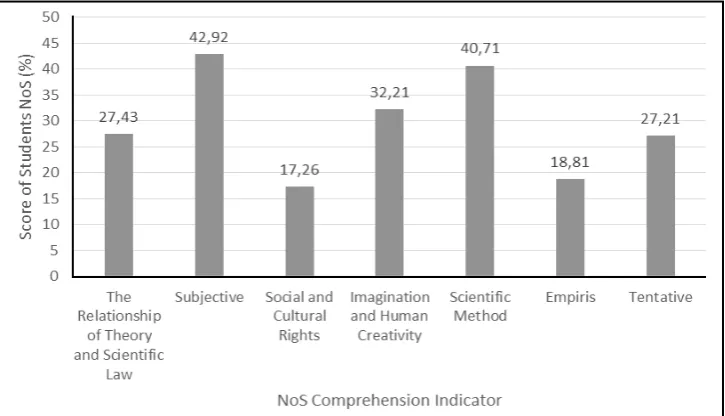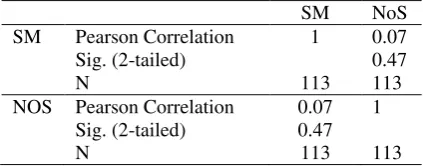Wicaksono, A. G. C., Minarti, I. B., & Roshayanti, F. (2018). Analysis of students’
Vol. 4 No. 1, 2018; pp. 35-42 ISSN: 2442-3750 (print); ISSN: 2527-6204 (online)
http://ejournal.umm.ac.id/index.php/jpbi
Received: 08/02/2018 Revised: 25/03/2018 Accepted: 28/03/2018
JPBI (JURNAL PENDIDIKAN BIOLOGI INDONESIA) Indonesian Journal of Biology Education
ANALYSIS OF STUDENTS’
SCIENCE MOTIVATION AND NATURE OF SCIENCE
COMPREHENSION IN MIDDLE SCHOOL
Azizul Ghofar Candra Wicaksono*, Ipah Budi Minarti, and Fenny Roshayanti
Department of Biology Education, Faculty of Mathematics, Sciences, and Information Technology Education, University of PGRI Semarang, Central Java, Indonesia
*corresponding e-mail: [email protected]
ABSTRACT
The purpose of this study was to explore the pattern of science motivation and nature of science (NoS) and the relationship between science motivation and nature of science in middle school students located in Semarang, Central Java, Indonesia. The design of this study was survey followed by the correlation study to discover the relationship between science motivation level and nature of science comprehension. This research included 113 students as sample. The instrument used for data collection was SMQ and seven essay test from NoS indicator. This study revealed that the students had a median score of science motivation and the low score in nature of science comprehension. There were students’ science motivation and nature of science comprehension urgently need to be improved. It can be done by developing learning process and any support from school or family.
Keywords: Comprehension, motivation, nature of science
© 2018 Department of Biology Education, FTTE, University of Muhammadiyah Malang, Indonesia
INTRODUCTION
Competence in science is necessary for life. The current application of science has pushed the world to more advanced and evolve beyond earlier eras (Whitehead, 2011). Moreover, in the global era, everyone is expected to have a good qualification in the context of science. The implication is that in the world of education, the science competency must also be learned to learners in an effective and efficient way so that created human beings with high science competence. Competence and mastery of science can be learned through learning that has elements of science. Inquiry-based learning, problem-based learning, along with other cooperative learning such as reciprocal teaching, jigsaw, cooperative script, and so on have been widely reported to improve students' cognitive and cognitive awareness of the content of science (Deta, Suparmi, & Widha, 2013; Wicaksono, 2016; Wulandari & Surjono, 2013; Yance, Ramli, & Mufit, 2013).
The application of t
hose
learning activities may have different outcomes (Halim, 2012; Siswati, 2014), depending on the conditions and existence of other variables that can indirectlyaffect the success of learners in the mastery of science. To be able to learn science appropriately, students must be able to recognize the nature of science. Therefore, an understanding of nature of science (NoS) is absolutely required by students in the process for further science. The definition of NoS is described by (Khalick, Bell, & Lederman, 1998) which states that NoS is a knowledge of epistemology (method) of science, the scientific process, or the value and belief inherent in developing science.
Wicaksono et al/ JPBI (Jurnal Pendidikan Biologi Indonesia) / 4 (1) (2018) pp. 35-42 the understanding of NoS is critical for students and the public to make informed decisions about social and personal issues scientifically.
In addition to the understanding of NoS, students success in learning science is also influenced by motivation factors (Hamdu & Agustina, 2011). Motivation in question is a motivation associated with science or commonly termed science motivation. Science motivation is an internal state that activates, directs, and keeps the learning behavior of science (Bryan, Glynn, & Kittleson, 2011; Glynn, Brickman, Armstrong, & Taasoobshirazi, 2011). The existence of science motivation in the learners will be a good start for them in studying science, at least they will have attitudes and behaviors that urge to be active in studying science.
Science motivation influences student’s behavior related to their achievement in science. Learners who are intrinsically motivated will work hard and learn more because there is an inner drive to make their goals (Odera, 2011). Thus, a high degree of motivation in the learners will indirectly affect their achievement in science.
The importance of understanding factors of NoS and science motivation in supporting science competence development of learners make the two factors as an essential part of studying science. Unfortunately, these two aspects are rarely noticed by educators. As many teachers in Indonesia focused on the acquisition of subject comprehension, cognitive, affective, and psychomotor aspect. Not all teachers know about NoS or science motivation, so students are not trained to understand and develop them. This is what makes it possible to be a reason in the low performance of Indonesian students' science, with a score of 403, ranking 61 out of 69
motivation and nature of science in junior high school students in Semarang. This research uses a mix method approach that is qualitative to describe an understanding of science motivation and NoS, and quantitatively by correlating between science motivation score and NoS score. Referring to the correlational design, the variable science motivation acts as a predictor determining the sample was done randomly from all schools.
The instruments used in this study include a questionnaire to measure science motivation and an essay test to measure students' understanding of NoS. The science motivation instrument is a questionnaire consisting of several statements covering the five aspects of science motivation as described by (Glynn et al., 2011) comprising value of career, Science Motivation Questionnaire (SMQ), New Ecological Paradigm (NEP), Science, Technology, Engineering, and Mathematics (STEM) career motivation. Completely, the five aspects of science motivation are outlined in Table 1.
A recap of the score given to the statements in the science motivation questionnaire was made with the following conditions: (1) statement of positive criteria science motivation for the value of career aspect: Yes = 1 and No = 0, and (2) statement for SMQ aspect, NEP, and STEM career motivation with positive criteria are: 5 = strongly agree, 4 = agree, 3 = quite agree, 2 = less agree, 1 = disagree. The determination of score categories using the PAP approach (Benchmark Reference Assessment).
Wicaksono et al/ JPBI (Jurnal Pendidikan Biologi Indonesia) / 4 (1) (2018) pp. 35-42
Table 1. Specification of the non-test instrument of science motivation questionnaire
No. Aspects Indicators No. Grain
Questionaire
1
Value of career (Kim & Yoo, 2012)
Understand its ability to develop career value and determine various motivation, initiative, and ability to adapt to a problem.
1-11
2 SMQ (Glynn et
al., 2011)
Understand the role of motivation to learn in many ways including in classroom attendance, classroom participation, and the amount of time spent learning, completion of tasks, asking questions, and seeking help and advice.
12-36
3
NEP (Dunlap, Liere, Mertig, & Jones, 2002)
Assess the environmental stewardship of a group of people (view of around population) or to measure an individual's belief about human relations and the ecological environment of "worldview".
37-51
4
STEM career motivation (Glynn et al., 2011)
Understand STEM's career motivation to summarize relevant and empirical concepts in informing change theories and evaluation strategies.
52-90
The NoS instrument uses an essay test compiled into seven structured questions based
on indicators from NoS (Khalick et al., 1998). The NoS indicator is outlined in Table 2.
Table 2. Indicators of nature of science (NoS)
No. Aspects Problem Indicators
1. Tentative Understanding the scientific tentative nature as part of science
2. Empiris Understanding the empirical role in generating scientific knowledge
3. Scientific method Understanding the role of creativity and human imagination in the idea that
science is not an imitation but a reality
4. Imagination and human
creativity
Understanding the role of creativity and human imagination in science
5. Social and cultural rights Understanding the social and cultural roles of this part of science
6. Subjective Assessing students' beliefs about personal opinions and theoretical
commitments
7. The relationship of
theory and scientific law
Understanding a common misconception about the relationship between science products
(Source: adapted from nature of science indicators Khalick et al., 1998)
The results of the essays/students understanding of NoS, scored by using the following conditions: (1) claim, has a score of 1, (2) data, has a score of 2, (3) supporters, have a score of 3, (4) claim accompanied by data, has a score of 3, (5) claim accompanied by supporters, has a score of 4, and (5) claim accompanied by supporters and data, has a score of 5. The scoring results are then converted to 100. Data of research result of science motivation and nature of science were analyzed using descriptive statistic and Pearson correlation analysis. The analysis is done by using SPSS 21.0 for Windows.
RESULTS AND DISCUSSION
The pattern of students’ science motivation
and nature of science
The general mastery of science motivation is at a middle level with an average score of
Wicaksono et al/ JPBI (Jurnal Pendidikan Biologi Indonesia) / 4 (1) (2018) pp. 35-42
In general, students have understood the importance of career as a reference in learning, unfortunately, a lot of them who have no interest in a career in the field of science. This can be seen from the low score STEM career motivation if Figure 1. The score for the STEM is at 67.53%, lower than other science motivation indicators. This condition indicates that students have low motivation in the career towards science, technology, engineering, and math. The result of the students' answers related to the low STEM career motivation has many aspects of family and school. Students show a low response when asked about advice and input from parents related to work in the field of science. Similarly, with regard to schools, students also provide a low response to the existence of consultations from schools related to opportunities and types of work in the field of science. This condition indicates that the family and school does not offer much response
and encouragement for students to be more inclined towards science.
Family and school environments are one of the factors that can contribute greatly to the career of students (Marini & Hamidah, 2014). Family and school factors in this case act as social support that can affect students in psychological aspects, productivity, and identity formation including career choice (Metheny & McWhirter, 2013). The family as the main director has the power to direct the child's career in the future. While the school provides support in the form of career guidance and career-oriented learning (Leksana, Wibowo, & Tadjri, 2014). Basically, every student has the freedom to choose especially related to career. nevertheless, the family and the school must give the greatest contribution to the service to the students, including guidance on career selection.
Figure 1. Score level of science motivation indicator
Aspects of motivation in science class and new ecological paradigm of students are in enough level. This indicates that students already have an interest in following science learning. Students are active and involved in science learning. The interest of students in science learning being an important capital to increase their efforts in learning science. The existence of motivation will support the learning achievement (Lestari, 2011). Students will be able to master the competence and scientific skills that will help them in overcoming the problems that will be faced later.
Wicaksono et al/ JPBI (Jurnal Pendidikan Biologi Indonesia) / 4 (1) (2018) pp. 35-42
learning outcomes are strongly influenced by effort (Schunk & Zimmerman, 2008). A high effort in learning and cognition will result in high effectiveness in learning including learning outcomes. This condition requires the teacher to make an extra effort to get the students involved more and spend a lot of time studying the science.
As for the aspect of new ecological paradigm intended to know one's concern for environmental conditions. With the hope that they can be motivated to learn science to have the ability to solve existing environmental problems. Based on the results of the questionnaire, students care in ecological aspects is good with a score of 72.53%. Students choose many aspects of natural resources development, animal and plant conservation. Students realize that their natural resources are abundant, and they must learn science to develop the resources wisely. Students also have an awareness to study
science in order to support the life of animals and plants that exist around them. Today many endangered animals and plants from year to year (Kusmana & Hikmat, 2015). This is one of the things that students are concerned about because they realize that the preservation of flora and fauna has a great impact on the balance of the environment, including for human life.
If the result of science motivation of junior high school students in Semarang is in enough level, it is different with the mastery of nature of science. The NoS student scores are at less level with a score of 23.36%. This result implies that students could not understand the essence of science. Science is seen only as a subject of learning and is considered difficult. Though the application of science is very closely related to everyday life. The complete results of student NoS mastery in each indicator can be viewed in Figure 2.
Figure 2. The differences level of NoS indicator
The results show that subjective and scientific method indicator has the highest score compared to other NoS indicators although only around 42,92% and 40,71%. The subjective aspect relates to the thinking and discovery of scientific researchers while human imagination and creativity are related to ideas and discoveries in science (Hardianty, 2015). In relation to the subjective aspect, some students have realized that in the discovery of science, scientists have different opinions, thoughts, and perspectives in examining the results of the experiments that obtained. The discovery of
Wicaksono et al/ JPBI (Jurnal Pendidikan Biologi Indonesia) / 4 (1) (2018) pp. 35-42
building theory will help students to think as much as a scientist (Hardianty, 2015). So the good score in scientific method aspect will help students to learn science better.
The lowest score of NoS understanding is in the sociocultural and empirical aspects. related to sociocultural aspects, many students have difficulty identifying the relationship between science and social culture. Most students assume that science is scope limited to theory while the culture of creativity and products of human art so that both do not affect each other. This shows that students level of thinking is still limited and not comprehensive. They fail to understand that science comes as a product of social and cultural activity in society (Lynd, 2015). The empirical aspect also gets the lowest score from the students' NoS understanding. Students have difficulties to understand the science knowledge of events occurring in the environment. Students are less sensitive to various problems that occur around them. Students are not trained to make observations or other scientific activities
The low understanding of science motivation and NoS in the students become a reminder for educators, especially in science education to better introduce science to students. It is not just introducing science content but more about training students to implement scientific processes. Students can be trained to position themselves as scientists and actors of science. Educators can also design an optimal learning environment and provide support in their learning process. Thus students can learn science much more optimally.
The relationship of science motivation and nature of science
Further studies were conducted to see if student motivation in students affects their understanding of NoS. The result of correlation analysis shows that science motivation and nature of science have a correlation coefficient of 6.8% with the significance of 0.472 (> 0.005) (Table 3). So it is concluded that there is no correlation between science motivation and nature of science. Although the score of science motivation is quite good students understanding of NoS still classified as less.
This condition raises the view that the existence of science motivation is not enough to develop the understanding of the nature of science. Mastery of NoS has a high complexity. Many aspects are involved. Mastering of NoS
means teaching students to move and think like a scientist (Khalick et al., 1998). Therefore, to be able to master the NoS can not only with the support of motivation. Various efforts are needed such as the use of certain methods and learning models (ex-discovery or inquiry), laboratory facilities and infrastructure, and multimedia (Cahyani, Rustaman, Arifin, & Hendriani, 2014; Hermansyah, Gunawan, & Herayanti, 2015).
Table 3. Correlation between science motivation and nature of science
Several other factors such as metacognitive skills, critical thinking skills, and attitudes are also shown to influence students understanding of science (Antika, 2017; Wicaksono, 2016). Moreover, from the results of science motivation questionnaire analysis can be seen that not all students are interested in a career in the field of science. They follow science learning focusing only on cognitive value. This makes students only get information about science alone without being able to think and act further in science. Most of the information will go into short-term memory and will not last long in student’s memory. This can lead to low NoS mastery of students. Therefore many
Wicaksono et al/ JPBI (Jurnal Pendidikan Biologi Indonesia) / 4 (1) (2018) pp. 35-42
science motivation and NoS comprehension. The high motivation actually didn't affect the acquisition of NoS in students, so whether science motivation and NoS should be taught by the teacher in different ways but still comprehensively. Thus learning process and the educational environment was needed to be improved especially in Semarang. Any research and development are required for the future understanding of science motivation and NoS.
REFERENCES
Antika, L. T. (2017). Hubungan antara minat baca, keterampilan metakognitif, dan keterampilan berpikir kritis dengan hasil belajar biologi siswa yang diajar dengan model reading-concept map-think pair share (TPS). Jurnal Pemikiran Penelitian
Pendidikan Dan Sains, 5(1), 28–35.
Retrieved from http://jurnal.uim.ac.id/ index.php/fkip%0D
Arifin, Z. (2009). Evaluasi pembelajaran. Bandung: Remaja Rosdakarya.
Bryan, R. R., Glynn, S. M., & Kittleson, J. M. (2011). Motivation, achievement, and advanced placement intent of high school students learning science. Science
Education, 95(6), 1049–1065. https://doi.
org/10.1002/sce.20462
Cahyani, R., Rustaman, N. Y., Arifin, M., & Hendriani, Y. (2014). Kemampuan kognisi, kerja ilmiah dan sikap mahasiswa non IPA melalui pembelajaran inkuiri berbantuan multimedia. Jurnal
Pendidikan IPA Indonesia, 3(1), 1–4.
Retrieved from https://journal.unnes.ac. id/nju/index.php/jpii/article/view/2894/0 Deta, U. A., Suparmi, S., & Widha, S. (2013).
Pengaruh metode inkuiri terbimbing dan proyek, terhadap prestasi belajar siswa.
Jurnal Pendidikan Fisika Indonesia, 9, measuring environmental attitudes: measuring endorsement of the new ecological paradigm: a revised NEP scale.
Journal of Social Issues, 56(3), 425–442.
https://doi.org/10.1111/0022-4537.00176 Gay, L. R., Mills, G. L., & Airasian, P. (2012).
Educational research: competencies for
analysis and application. Boston: Pearson.
Glynn, S. M., Brickman, P., Armstrong, N., & Taasoobshirazi, G. (2011). Science motivation questionnaire II: Validation with science majors and nonscience majors. Journal of Research in Science
Teaching, 48(10), 1159–1176. https://doi.
org/10.1002/tea.20442
Halim, A. (2012). Pengaruh strategi pembelajaran dan gaya belajar terhadap hasil belajar fisika siswa SMPN 2 Secanggang Kabupaten Langkat. Jurnal
Tabularasa PPS UNIMED, 9(2), 141–158.
Hamdu, G., & Agustina, L. (2011). Pengaruh motivasi belajar siswa terhadap pestasi belajar IPA di sekolah dasar. Jurnal
Prosiding Simposium Nasional Inovasi
dan Pembelajaran Sains (Vol. 2015, pp.
441–444). Bandung.
Hermansyah, H., Gunawan, G., & Herayanti, L. (2015). Pengaruh penggunaan labora-torium virtual terhadap penguasaan konsep dan kemampuan berpikir kreatif siswa pada materi getaran dan gelombang.
Jurnal Pendidikan Fisika Dan Teknologi,
I(2), 97–102.
Khalick, F. A., Bell, R. L. & Lederman, N. G. (1998). The nature of science and instructional practice: Making the unnatural nature. Science Education,
82(4), 417–437.
Kim, S. K., & Yoo, M. H. (2012). Comparison on the vocational values and the science career orientation between middle school scientifically gifted students and non-gifted students. Journal of the Korean Association for Research in Science
Education, 32(7), 1222–1240. https://doi.
org/10.14697/jkase.2012.32.7.1222 Kusmana, C., & Hikmat, A. (2015). The
biodiversity of flora in Indonesia. Journal of Natural Resources and Environmental
Management, 5(2), 187–198. https://doi.
org/10.19081/jpsl.5.2.187
Lederman, N. G., Khalick, F. A., Bell, R. L., & Schwartz, R. S. (2002). Views of nature of science questionnaire: Toward valid and meaningful assessment of learners’ conceptions of nature of science. Journal
of Research in Science Teaching, 39(6),
Wicaksono et al/ JPBI (Jurnal Pendidikan Biologi Indonesia) / 4 (1) (2018) pp. 35-42
Lederman, N. G., Lederman, J. S., & Antink, A. (2013). Nature of science and scientific inquiry as contexts for the learning of science and achievement of scientific literacy. International Journal of Education in Mathematics Science and
Technology (IJEMST), 1(3), 138–147.
https://doi.org/10.18404/ijemst.19784 Leksana, D. M., Wibowo, M. E., & Tadjri, I.
(2014). Pengembangan modul bimbingan karir berbasis multimedia interaktif untuk meningkatkan kematangan karir siswa.
Jurnal Bimbingan Konseling, 3(2), 6.
Lestari, N. N. S. (2011). Pengaruh model pembelajaran berbasis masalah (problem-based learning) dan motivasi belajar terhadap prestasi belajar fisika bagi siswa kelas VII SMP. Journal Teknologi
Pembelajaran Indonesia, 1(1), 1–21.
Lynd, R. S. (2015). Knowledge for what: The place of social science in American
culture. N.Jersey: Pricenton Univ. Press.
Marini, C. K., & Hamidah, S. (2014). Pengaruh self-efficacy, lingkungan keluarga dan lingkungan sekolah terhadap minat berwirausaha siswa SMK jasa boga.
Jurnal Pendidikan Vokasi, 4(2), 195–207.
Marôco, J., & Gonçalves, C. (2015). Pisa 2015, 16.https://doi.org/http://dx.doi.org/10.178 7/9789264266490-en
Metheny, J., & McWhirter, E. H. (2013). Contributions of social status and family support to college students’ career decision self-efficacy and outcome expectations. Journal of Career
Assesment, 21(3), 378–394.
Odera, F. Y. (2011). Motivation : the most ignored factor in classroom instruction in Kenyan Secondary Schools. Int. J. of
Science and Technology, 1(6), 283–288.
Sadler, T. D., Burgin, S., McKinney, L., & Ponjuan, L. (2010). Learning science through research apprenticeships: A critical review of the literature. Journal of
Research in Science Teaching, 47(3),
235–256.https://doi.org/10.1002/tea.20326 Schunk, D. H., & Zimmerman, B. J. (2008).
Motivation and self-regulated learning:
theory, research, and applications. New
York: Lawrence Erlbaum Associate. Siswati, B. H. (2014). Hubungan antara
keterampilan metakognitif dengan hasil belajar siswa berkemampuan akademik berbeda pada pembelajaran biologi yang
menerapkan beberapa model
pembelajaran. Univ. Negeri Malang.
Retrieved from http://karya-ilmiah.um. ac.id/index.php/disertasi/article/view/3147 Sudirgayasa, I. G., Suastra, I. W., & Ristiati, N. P. (2014). Pengaruh model pembelajaran berbasis Nature of Science (NoS) terhadap kemampuan aplikasi konsep biologi dan pemahaman NoS siswa dalam pembelajaran biologi di SMA Negeri 1 Marga. Jurnal Pendidikan IPA Indonesia,
4(1), 1–12.
Whitehead, A. N. (2011). Science and the
modern world. Cambridge: Cambridge
University Press.
Wicaksono, A. G. C. (2016). Perbandingan kemampuan kognitif dan metakognitif mahasiswa dengan gaya belajar yang berbeda. Jurnal Media Penelitian
Pendidikan, 10(2), 142–153. https://doi.
org/10.26877/mpp.v10i2.1516
Wong, S. L., Hodson, D., Kwan, J., & Yung, B. H. W. (2008). Turning Crisis into Opportunity: Enhancing student‐teachers’ understanding of nature of science and scientific inquiry through a case study of the scientific research in severe acute respiratory syndrome. International
Journal of Science Education, 30(11),
1417–1439. https://doi.org/10.1080/09500 690701528808
Wulandari, B., & Surjono, H. D. (2013). Pengaruh problem-based learning terhadap hasil belajar ditinjau dari motivasi belajar PLC di SMK. Jurnal
Pendidikan Vokasi, 3(2), 178–191.
https://doi.org/10.21831/jpv.v3i2.1600 Yance, R. D., Ramli, E., & Mufit, F. (2013).
Pengaruh penerapan model project-based learning (PBL) terhadap hasil belajar fisika siswa kelas XI IPA SMA Negeri 1 Batipuh Kabupaten Tanah Datar. Jurnal



